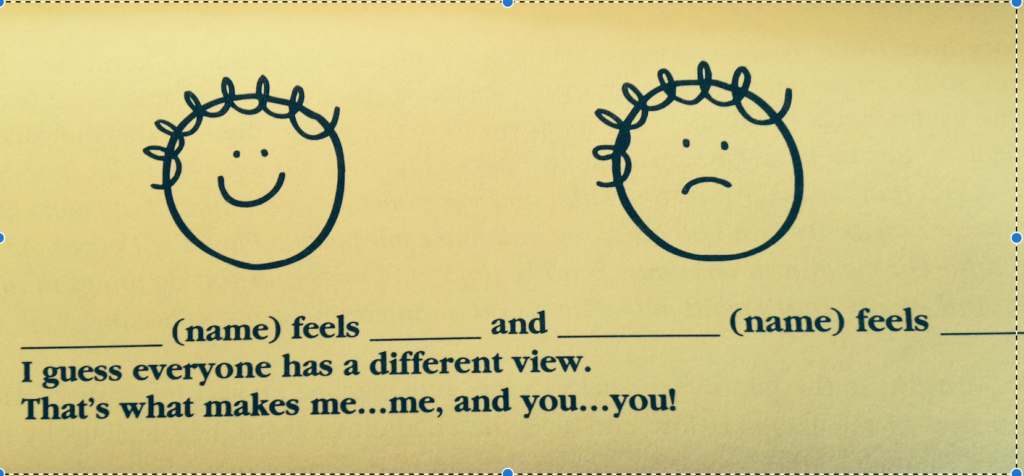Raising Kids to Think We, Not Me!
The gateway to learning to empathize, accepting differences and understanding another’s perspective is an emotion vocabulary. But when children can identify, name and understand different emotions, it’s time to help children practice understanding other’s feelings and thoughts. Doing so is a critical step towards helping children understand and accept differences and to learn the crucial cognitive component of empathy, perspective taking.
Young children are by nature egocentric and must first see the world from their own point of view. Teens can also revert back to that “Me First” mentality. Thinking and feeling as though the world revolves around you makes it difficult to see someone else’s point of view. That’s why Daniel Goleman reminds us: “Self-absorption kills empathy.” But empathy can be cultivated; children can learn perspective taking skills.
Repeated experiences of listening to the views of others is one way to help children develop empathy and appreciate differences.
The key is to emphasize again and again: “You don’t have to agree with the person’s view. Your goal is to try to understand what the person is feeling or thinking. Listen deeply. Keep an open mind.”
And that takes a lot of time and a lot of practice. Here are three ways to help children understand and accept differences.
1. Ask Questions and Have Open-Ended Discussions
Face to face conversations and deeper discussions in which kids hear other views are crucial to developing perspective taking and empathy. Digital natives who prefer texting, tapping and tweeting over talking will be handicapped. So take time during those family dinners, car pools, class meetings or just one-on-one conversations to help kids recognize that people may share similar feelings, but hold different views. And that’s okay.
The trick is for each student, sibling, friend or family member to express their opinion calmly, and then listen to the other person without judgment. It’s how children begin to recognize it’s okay to feel and think differently and accept those differences.
Here are a few easy questions to get you started. Then slowly take your questions up to more stirring and controversial queries.
First level questions for younger kids to grasp it’s okay to have different views
• How do you feel when the teacher calls on you? Do you feel the same in every class? Why?
• How do you feel about playing or watching soccer (tennis, skiing, baseball, basketball)?
• How do you feel about reading (math, science, history, geography)?
• How do you feel when it rains all day?
• How do you feel when you’re in the dark?
Higher level questions and more controversial topics for teens
• Should schools ban students from bringing cell phones on campus?
• Do teachers assign too much homework? Do you think homework is relevant? How can homework be made more relevant?
• Should schools start classes later?
• Should stores sell violent video games to minors?
• Does technology get in the way of learning?
• How can people learn to get along?
2. Hold Debates
Debating is a great way to help kids learn perspective taking as well as find their voice. So why not start family or class debates? Topics could range from class issues such as your rules and homework policies and family issues such as allowances and curfews to real-world issues such as the welfare system, voting age or current headlines. Whatever the topic, encourage your kids to speak out so they’ll be more comfortable defending their beliefs in public. Debating also helps kids define who they are and strengthens their Caring Mindsets and Moral Identities.
3. Use Literature to Help Kids Think “We,” Not “Me”
Books are one of the best vehicles to help children journey into other worlds. The following selections are wonderful catalysts to any discussion regarding “different points of view.” Read the book aloud or have children read solo style. Then ask them to use the formula above with the two different characters.
(Name) feels ___________and (name) feels__________________.
For younger children add: I guess everyone has a different views. That’s what makes me…, and you…you!”
For younger children:
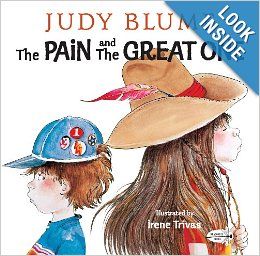 The Pain and the Great One by Judy Blume. This picture book is written from two perspectives and in two parts. The older sister (“The Great One”) thinks her younger brother is a bothersome pain who gets way too much parental attention. The younger brother (“The Pain”), from his perspective thinks his sister gets too much love just because she’s older. I’ve used this one countless times with kids and always creates stimulating discussions as well as a fabulous writing prompt.
The Pain and the Great One by Judy Blume. This picture book is written from two perspectives and in two parts. The older sister (“The Great One”) thinks her younger brother is a bothersome pain who gets way too much parental attention. The younger brother (“The Pain”), from his perspective thinks his sister gets too much love just because she’s older. I’ve used this one countless times with kids and always creates stimulating discussions as well as a fabulous writing prompt.
The True Story of the Three Little Pigs by Jon Scieszka. The wolf gives his own outlandish version of what really happened when he tangled with the three little pigs. Fun! Extend the conversations to other classics and discuss the perspective of characters like Jack and the Beanstalk, Cinderella, Beauty and the Beast.
The Bedspread by Sylvia Fair. Two elderly sisters embroider the home of their childhood at both ends of a white bedspread. Each depicts the home as she remembers it with surprising results. The book’s message is that everyone has a different viewpoint and there may be no one correct view. And that is a crucial message for kids to understand.
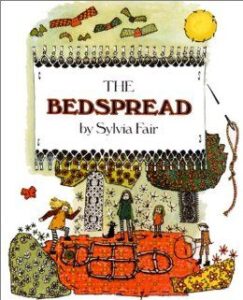 Bea and Mr. Jones by Amy Schwartz. Tired of kindergarten, Bea Jones trades “jobs” with her father who works in an office. Just a great conversation starter .. whether it’s switching roles with the principal, teachers, dad, mom, brother, sister … to help kids see things from another side.
Bea and Mr. Jones by Amy Schwartz. Tired of kindergarten, Bea Jones trades “jobs” with her father who works in an office. Just a great conversation starter .. whether it’s switching roles with the principal, teachers, dad, mom, brother, sister … to help kids see things from another side.
Through Grandpa’s Eyes by Patricia MacLachlan. A young boy learns a different way of seeing the world from his blind grandfather. Touching!
For older kids and teens
Encounter by Jane Yolen. A Taino Indian Boy on the island of San Salvador recounts the landing of Columbus and his men in 1492. While most stories about the first encounter are from Columbus’ point of view, Yolen thought it would be interesting for readers to hear a Taino boy speak. And interesting it is.
Paperboy by Vince Vaxter. Award-winning coming-of age book teaches empathy and courage.
The Boy on the Wooden Box by Leon Leyson. A moving memoir of a Holocaust survivor on Schindler’s List. Powerful! “Can you imagine living through those times? Why do you think he didn’t want anyone to know? What would you have done?” There is also a movie version.
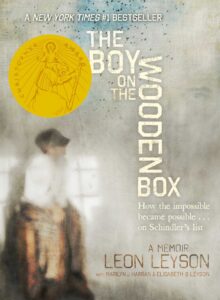 Dear Bully: 70 Authors Tell Their Stories. Kids, teens and authors share personal bullying experiences. “Put yourself in her shoes. How would you feel? What could you do to help?”
Dear Bully: 70 Authors Tell Their Stories. Kids, teens and authors share personal bullying experiences. “Put yourself in her shoes. How would you feel? What could you do to help?”
Grapes of Wrath by John Steinbeck. Emotionally-charged book brings depression to life. “How would you feel if you had to live through those times?”
Follow me as I share ways we can cultivate our children’s empathy, help them learn perspective taking and appreciate differences, and switch their attitudes from WE, not ME.
It’s time for a national conversation about why empathy and character matter! I hope you join me!
Dr. Michele Borba
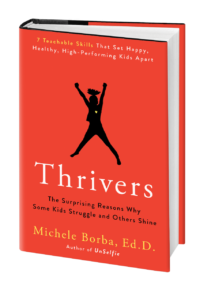 I’m excited to announce that my new book, Thrivers: The Surprising Reasons Why Some Kids Struggle and Others Shine will be released on March 2021. It explains why the old markers of accomplishment (grades, test scores) are no longer reliable predictors of success in the 21st century — and offers 7 teachable character strengths that boost resilience and will safeguard our kids for the future
I’m excited to announce that my new book, Thrivers: The Surprising Reasons Why Some Kids Struggle and Others Shine will be released on March 2021. It explains why the old markers of accomplishment (grades, test scores) are no longer reliable predictors of success in the 21st century — and offers 7 teachable character strengths that boost resilience and will safeguard our kids for the future
Also check out: UnSelfie: Why Empathetic Kids Succeed in Our All-About-Me World. You’ll find dozens (over 300) simple, proven ways to cultivate empathy in children as well as help them learn the nine essential habits that nurture empathy. The book is now in hardback as well as paperback and Kindle.



